Being There
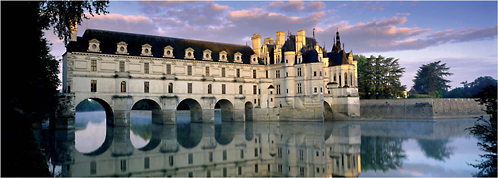
Château le Chenonceau, Loire Valley, France
Under a grey sky with the wind whipping the water this scene looked fairly sombre. The key was to envisage how it could look with the first soft light of day and perfect reflections.
• Fuji GX617, 105mm lens
Being in the right place at the right time is, of course, the prime essential of all photography. ‘Being There’ is all about the finding, visualizing and planning of an image before shooting the picture. A seasoned pro will have an uncanny knack for it. Whatever the discipline – sports, news, wildlife, fashion or landscape – it’s the same for all of us. Finding that special place is the hard grind of this game, it’s what takes up the most time and effort, and is without doubt one of the big differences between making a great shot and taking a snap. Knowing what to do once you are there is the second half of the equation that produces strong images.
So, where to begin? It’s important to have a starting point, an idea of what you’re after, whether you’re in the Rocky Mountains or the Loire Valley. Aimlessly wandering is rarely productive. Guide books, existing photographs, other travellers or local knowledge can all be useful, but ultimately there’s no substitute for getting the boots on and eyeballing the lie of the land. It’s time consuming and often frustrating, but it has to be done. There’s nothing worse than being somewhere tantalizing with gorgeous light splashing across the landscape and not knowing where to head to get the shot as the sun starts to drop. Just to go to where everyone else has been, to the well-known viewpoint, to replicate what has been done countless times before, is not an option. That’s just taking a snap. To make something special means getting out and looking; using your most important piece of kit – your eyes.
Once that magical spot is found the key is to visualize how it could look in different lighting conditions at the beginning or end of the day, taking into account where the sun is rising and setting in relation to the lie of the land and seasonal factors. This is a skill that comes hand-in-hand with a feel for natural light and is crucial for all location work. It can’t really be taught, it’s a case of looking and learning. Really use your eyes to analyse every element in the scene.
After all that it becomes a logistical exercise, planning how and when you’re going to be in the chosen place at the right time. That can be as easy as a drive and a stroll, or can mean several hours hiking in the dark before dawn. Compared to all that, shooting the picture is the easy bit.
“Really use your eyes to analyse every element in the scene”
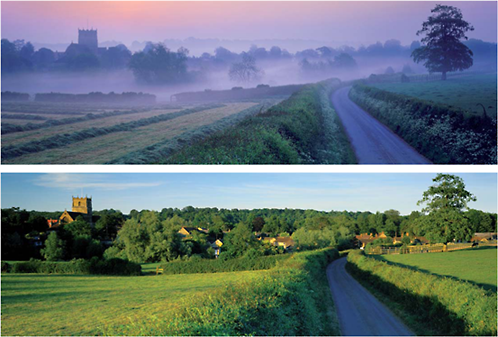
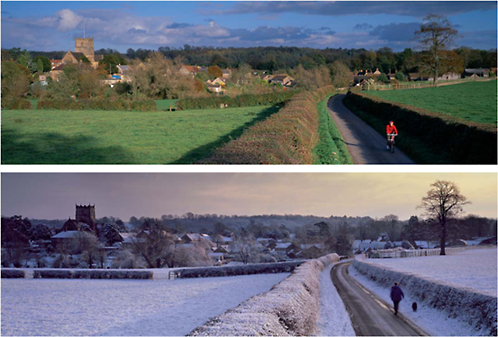
The Four Seasons, Milborne Port, Somerset-Dorset border, England
I wanted to do a set of images with identical compositions to illustrate the passage of the four seasons. Finding a location with a strong composition that would work in the different lighting conditions of the seasons was the key. I shot from the roof of my Land Rover to get above the level of the hedgerows. Winter was the shot I was most worried about; snowy conditions with crisp morning light are a rarity in deepest Dorset. I shot this at dawn with the first light creeping over the village from the southeast and the Vicar looking bemused as he walked his dog. Spring was shot at dawn straight into the light before the sun popped over the horizon, with mist lying in the fields. I love the soft watercolour feel of this one. Summer was shot late on a June evening with the last sun sidelighting the village from the northwest, and autumn featured Wendy on her bike on an October afternoon. I tied a marker in the hedge to mark my spot after shooting winter, but I guess a cow must have munched it, because it wasn’t there in spring.
• Fuji GX617, 180mm lens
The Old Man of Storr, Isle of Skye, Scotland
It’s windy, it’s wet, my cameras are untouched, the Land Rover is full of soggy camping gear and the midges are swarming – all typical conditions here on the Isle of Skye. With the fiery Cuilin Ridge, the matured Trotternish and salty coastlines all garnished with dashes of northern light, Skye serves a heady photographic menu. There is, however, one major drawback: the weather. Oh, and let’s not forget the midges. We’ve spent four days location searching; now, we wait. Dramatic sky, gorgeous dawn light highlighting the pinnacles of the Old Man of Storr, the Cuilin beyond with an endlessly receding vista of loch, mountain and sea – this is what I require - I want it all. However, what I require and what nature deigns to provide are often poles apart. I’ve had this image in the back of my head now for ten years; it may have to wait another ten.
Now, sipping Talisker in the evening, I’m pondering the chances of getting dawn light. The fronts are piling in off the Atlantic with relentless regularity, and anything could happen. We have to go for it, so it’s a 5am start with a one-hour climb to be in place by sunrise. I’m concerned about these winds though; they’ll give me problems. It doesn’t matter how sturdy my tripod is, gale force winds make life difficult.
At 5am, I can see stars through broken cloud cover. Up the hill we plod, wondering if I’m too old for this, lungs pounding, I don’t want to be late. Maybe I should go back to window cleaning. Wendy is behind with another tripod in case I want to double up on 35mm. What a trooper. Big black clouds are sweeping over the ridge promising rain, but in-between there are clear gaps. It could be good; it all depends on those clouds massed over the Torridons to the east. Finally, we’re up there in the half-light of dawn. The wind is whistling over my chosen mound, we can’t even stand still, but I manage to find a ledge that is reasonably sheltered tucked away just below
“What I require and what nature deigns to provide are often poles apart”

the summit. I want to set up the camera and wait but every few minutes there’s a shower, so I have to keep it in the bag until the last moment. I’m using my Fuji GX617 with a 90mm lens, 220 Velvia, no fancy filtration here, just a 0.9 ND grad on the sky. I’ll let the quality of light and composition take care of the rest. We’d been up here a few days ago to check it out. When the light is good I need to be ready, not still debating my options.
Wendy is watching the sky to the north, letting me know when likely breaks in the clouds will occur. The sun is just up but obscured by cloud, but I’m getting increasingly optimistic and excited. The sky is fantastic, as is often the case between showers. I go through my usual pre-shooting checks, then do it all again. This is a routine I’ve been all through so many times, but you can never take it for granted.
Out of nowhere, golden light explodes on to the scene, bathing the landscape in gorgeous crystal clear light … sheer absolute perfection. The pressure is on now, this may only last a few seconds. Spot meter reading on the pinnacles, set aperture, shoot … 1/3-stop brackets either side, the exposure is changing as I’m exposing. Eight frames gone, reload; with high winds and cold hands it’s no time to be messing about, this needs all the efficiency of a Ferrari pit stop. I get off a few more frames before the light goes. Did I get it? Will we get another chance? Did I get the exposure right? Is the filter OK? Any rain on the lens? All the usual doubts.
The sun comes out again about 20 minutes later, but it doesn’t quite have the quality of earlier. I float back down the hill on air, buzzing, knowing we’ve witnessed one of those special moments. When it’s good, Scotland is very, very good. Maybe I’ll put off a return to window cleaning for now.
After that morning the rain clouds close in again. We cross to Harris but don’t shoot a single picture. So, two weeks’ work boils down to a two-minute burst of light. But it was worth it.
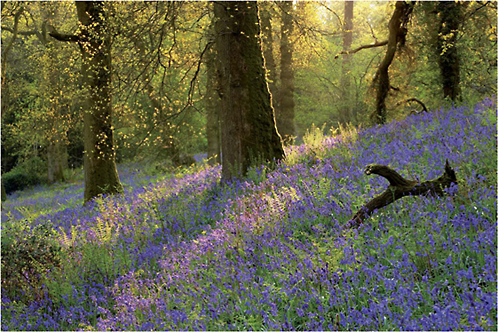
Bluebells in a wood, Dorset, England
I’m kneeling in amongst the bluebells on a spring evening with soft light filtering through the trees, gently backlighting the scene. How did I find this spot? I went for a walk. Location finding isn’t rocket science, it’s just getting mud on your boots.
• Canon EOS-1Ds MKII, 70–200mm lens
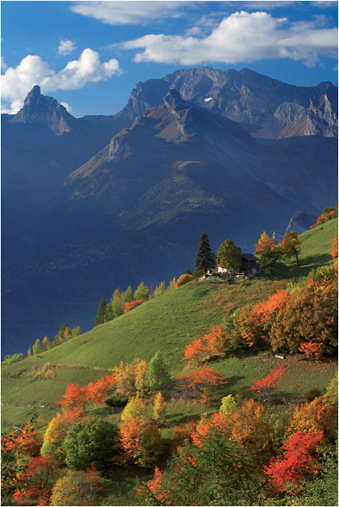
Autumn colours at Isérables above the Rhone Valley near Sion, Le Valais, Switzerland
The late afternoon light catches the alpine autumn colours above the Rhone Valley. This is an image that could only work in autumn. Being There is usually dependent on the seasons. I’ll often ‘bank’ a location with the idea of returning when the right seasonal conditions prevail – it could be months or years later. A good idea for a unique image is a valuable asset.
• Canon EOS-1Ds MKII, 70–200mm lens
